We express ourselves through plants. There are the bouquets of flowers we gift to lovers, the houseplants we bring in as new roommates, the care of tended gardens that feed and beautify, the curation of manicured landscaping along sidewalks and suburban front yards and across public parks. Frames of kaleidoscope green through which we experience the world, telling stories about who we are, where we live, who we want to be. But plants also express themselves to us. They express their unhappiness with drooping stems and yellowing leaves, or contentment with a flower’s colorful bloom. They defy us by sprouting up through pavement cracks, wrapping their roots around pipes and climbing up buildings, growing where they’re not welcome. They tell us the time of day, the season, or the year with the unfurling of petals, the flutter of leaves, eager sprouts pushing up through soil. They are delicate, sensitive, yet so uniquely resilient even as we continue to consume and uproot them.
I’ve been thinking a lot about the botanical world, especially as we slip into midsummer. It’s a time that brings an intensity of the senses, punctuated by the sap-like feeling of sweat on your skin and the cool relief of finding shade under leafy greens. So for this month’s newsletter, let’s plant some seeds of wonder.
TOUCH
Did you know that Hilma Af Klint, beloved abstractionist, was once obsessed with flowers? I recently saw an amazing show at MoMA of Klint’s botanical illustrations. Created over a year of profound fascination with the natural world and plant science, it was amazing to see her spiritual abstracted style come through these vibrant watercolor studies. In addition to the drawings, Klint would describe each species and their power, interconnecting the human soul and the plant world. My favorites were the Yellow Iris (belief in the creation act) and Forget-me-not (longing for tenderness).
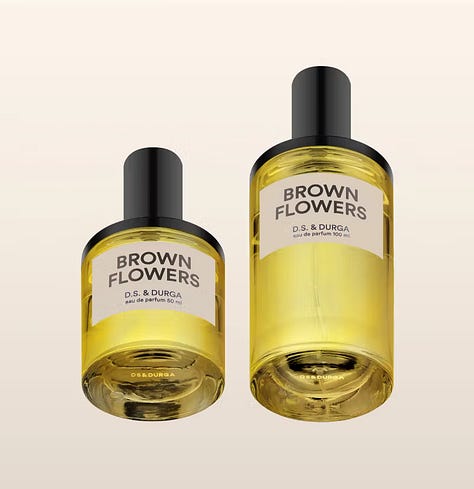
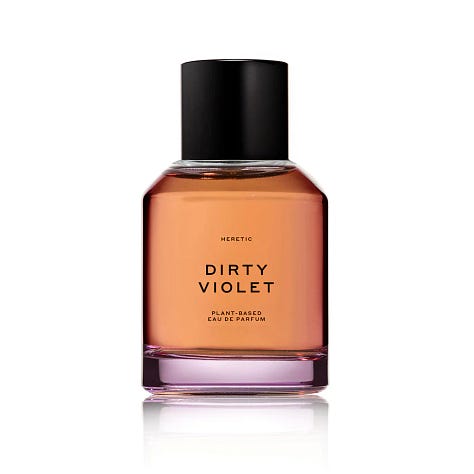
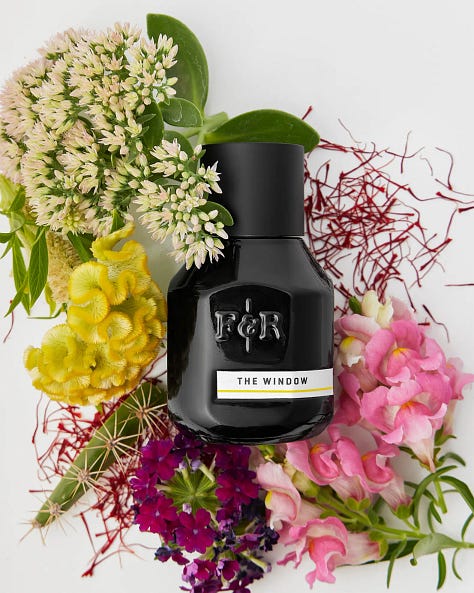
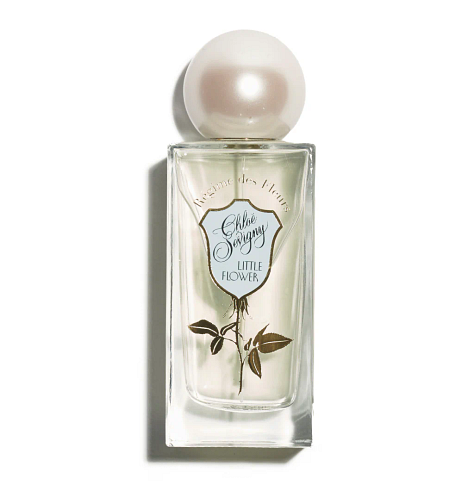
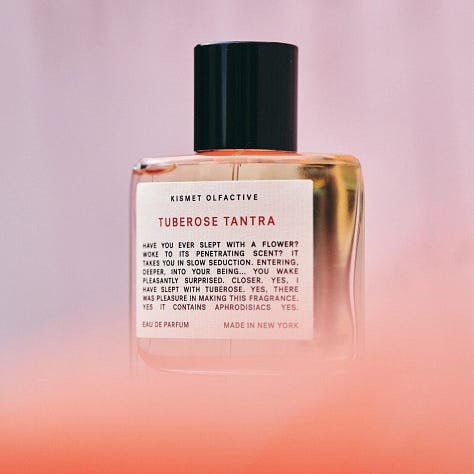
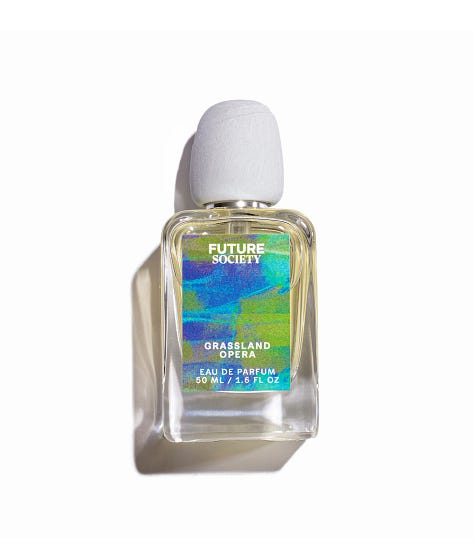
I can't talk about the botanical without mentioning a few of my favorite floral perfumes. When I first smelled D.S. and Durga’s Brown Flowers, I was reminded of the graceful rot of my family’s orchids when we brought them inside for hurricane season, and it’s become a go-to ever since. I got Heretic Parfum’s Dirty Violet in a discovery set recently and it’s now one of my favorite interpretations of violet with its glam punk seductiveness. Fulton & Roark’s The Window smells like opening a window out onto a hot desert in bloom with an array of native plants, ylang ylang, and lavender. Then there’s Little Flower by Regime Des Fleurs, made in an iconic collaboration with Chloe Sevigny, whose delicate rosy musk makes me feel like a princess. Kismet Olfactive’s Tuberose Tantra is a gorgeous wave of white florals, rich with dreamy jasmine and tuberose—one of my most complimented scents. Future Society’s Floating Forest takes a greener, more aquatic turn with notes of freesia, water lily, and papyrus thanks to its inspiration from an extinct Borneo forest.
Zoë Schlanger’s The Light Eaters is a thoughtful study of dramatic changes unfolding in the field of botany, especially around theories of plant intelligence. As Schlanger, a climate journalist, falls deeper into this experimental scientific world, we meet the researchers at the forefront of this emerging (and controversial) field who are radically re-shaping our understanding of how plants socialize, communicate, feel, and relate to the world around them. You’ll never look at your ordinary houseplants the same way again. Schlanger writes: “It is hard to underestimate the drama of being a tree, or any plant. Every one is an unimaginable feat of luck and ingenuity. Once you know that, you can't unknow it.”
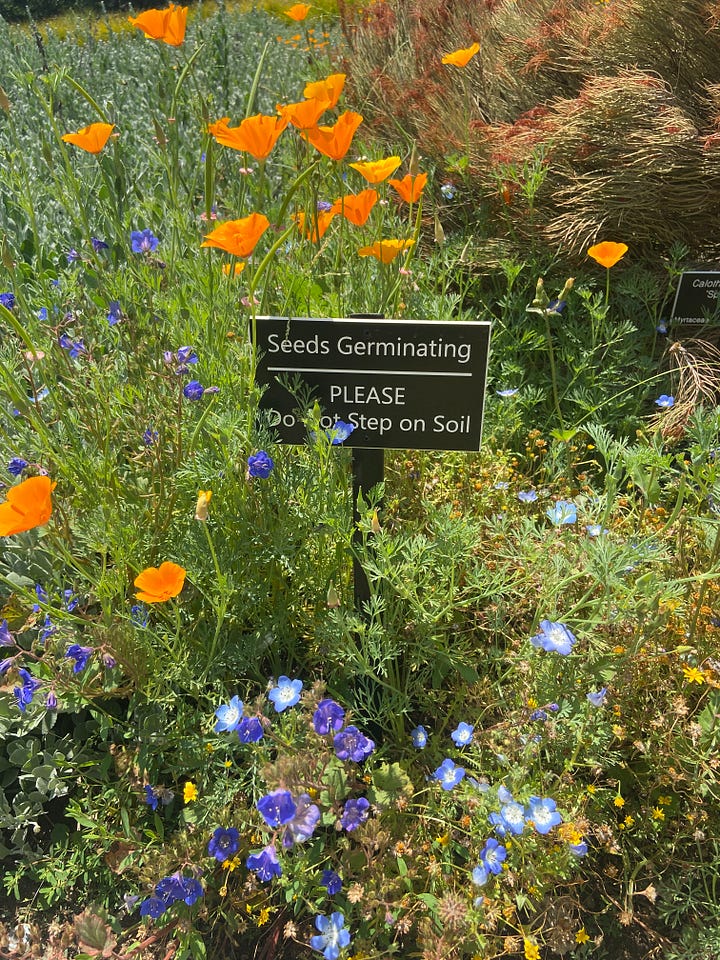
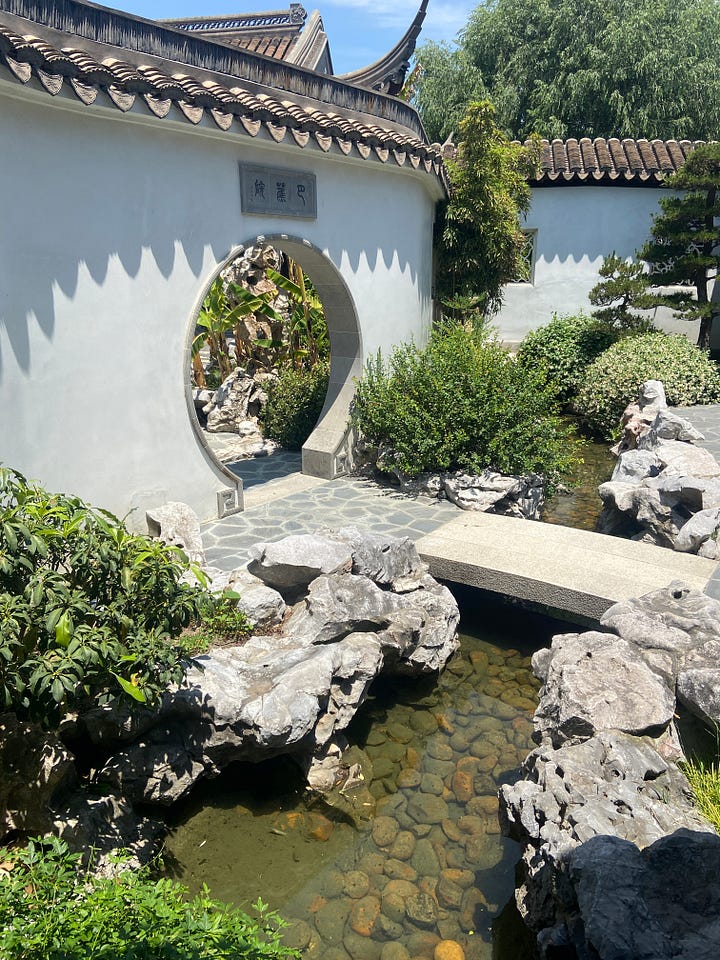
Back in May, I was in Pasadena for a wedding and ended up visiting The Huntington. This sprawling estate of botanical gardens was established in 1919 as an educational institution, research library, and over a dozen themed gardens for visitors and scholars to explore. Despite the hot California sun beating down on us, it was amazing to wander through each curated landscape and take in the lush diversity of our botanical world. Can’t wait to return to explore their Octavia Butler archives.
LOOK
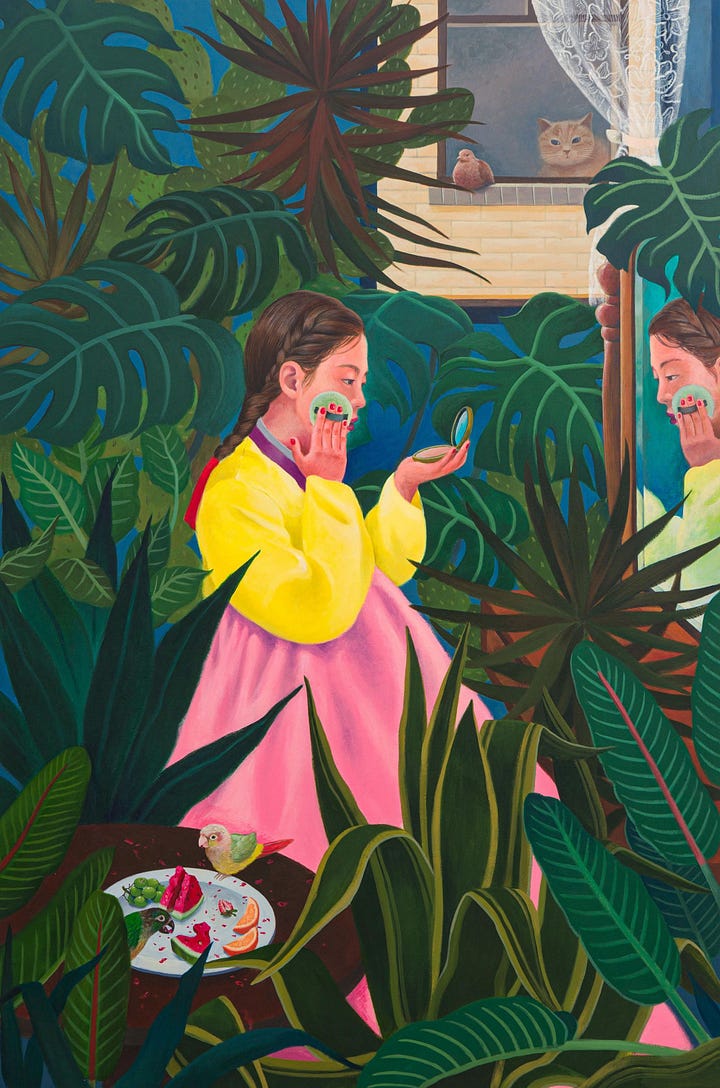
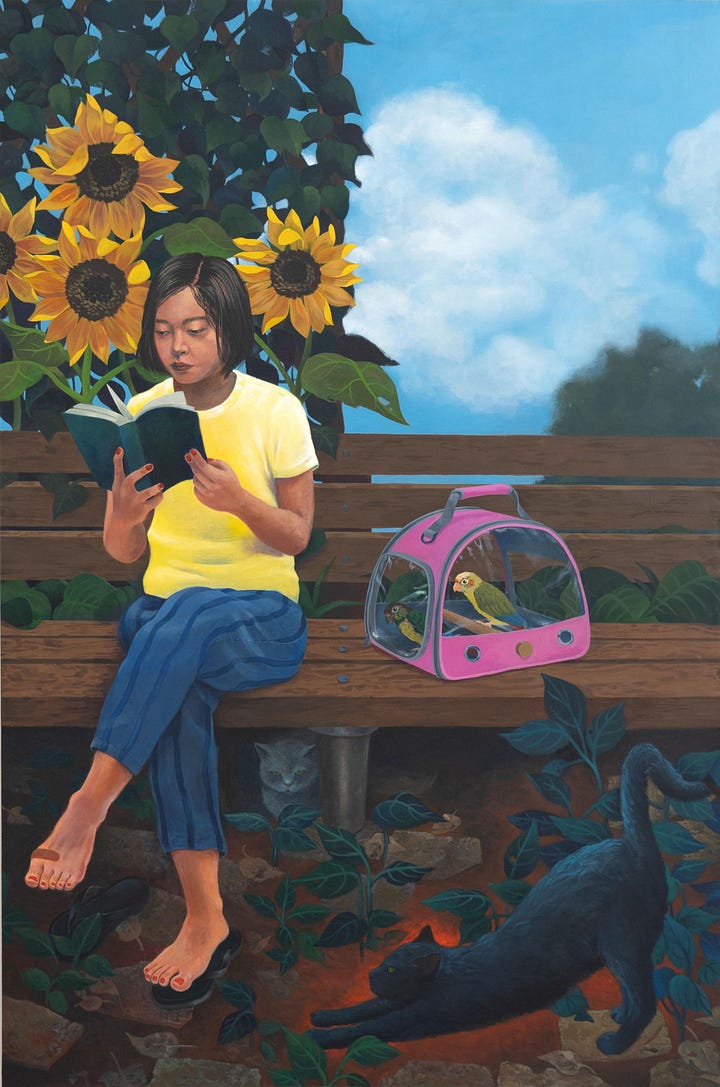
On my lunch break last week, I slipped into Salon 94 to check out their exhibition by Korean artist Sally J. Han. Titled “Wallflower,” Han uses flowering botanical motifs to depict the richness of young girls’ inner worlds. These larger-than-life paintings are intimate scenes of private curious creativity, welcoming you to spend time closely examining the little details Han hides among her lush foliage and blooms. As researcher and curator Fabiola Alondra writes in an exhibition essay: “Wallflowers are, above all, quiet witnesses, rooted in the margins, attentive to life.”
For the second time, I encountered one of Rashid Johnson’s monumental plant installations. This time at his Guggenheim solo show, “A Poem For Deep Thinkers.” Titled Sanguine, the piece appears to spill out of its containment on the top floor of the museum’s rotunda, sending a cascade of suspended plants, palm trees, and vines down its central core. Known for his gridded-steel structures packed to the brim with vegetation, ceramics, books, shea butter, and other found objects illuminated by the harsh neon of grow lights, this built environment also houses a film by the same name that explores the intergenerational relationship between Johnson, his father, and his son. Flowers and plants are regular motifs in Johnson’s work, appearing as symbols of growth, protection, and sustenance alongside his exploration of Black cultural and intellectual histories. In this instance, their inclusion in the gallery is also a nod to Frank Lloyd Wright’s original desire to decorate the museum with plants. Through Johnson’s careful staging, the galleries become vivid spaces for living.
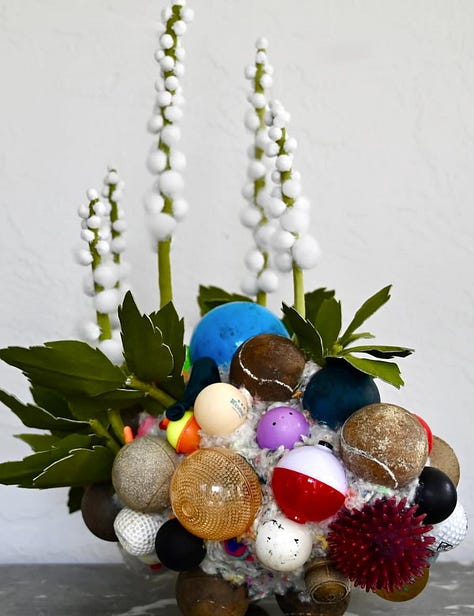

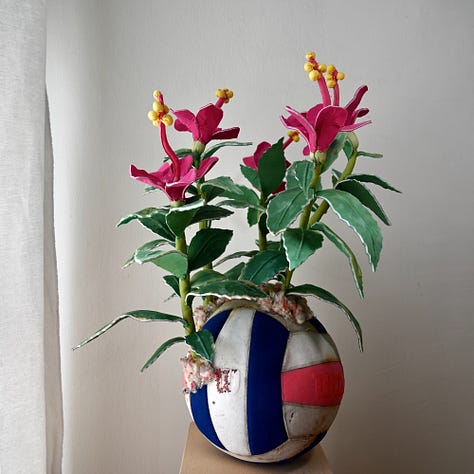
Alissa Alfonso is a South Floridian artist that renders the resilience of plants in our polluted, ecologically-disconnected world through dreamy soft sculptures that seem to bloom out of discarded sports balls and plastics. Alfonso constructs the works in her series “Nature’s Medicine” by hand-dyeing textile waste and stuffing them recycled fibers and salvaged materials. I love how Alfonso captures the likeness of these flowers (which include healing species like hibiscus, black cohosh, and pipewort) but uses fabrics to play with the geometry and texture of their forms, entangling together the natural and the artificial.
For a month, a bouquet of cryogenically-frozen lilies sat in the window of art gallery Blade Study. Know as Lilies Into The Void, the piece was part of a solo show by artist Jo Shane that explores the commercialization of “life” through the medical and wellness industries. By prolonging the flowers’ existence in a zombie-like state of suspended animation through a refrigerated coffin-like structure, Shane reflects on economies of aging, mortality, bodily disruption, and the modern business of staying alive.
LISTEN
Last year, the New York Botanical Garden launched Plant People, a podcast that looks at the role of plants in our lives from science to society. It’s quickly become one of my favorite listens, with episodes full of accessible plant education and fascinating interviews that feature botanical researchers, historians, and creative people from around the world. A few of my personal highlights from their first and second seasons: extreme botany, Black histories of gardening, bettering our grass lawns, an environmental history of the Bronx, and learning to love decay.
And then there’s the gorgeous “God Turn Me Into A Flower” by Weyes Blood. I remember first hearing this song and being so struck by the lyric: “It's good to be soft when they push you down.” Such a haunting melody that poignantly lingers on the hard and beautiful bloom of being alive in this world like a petal about to be plucked.
Memory Garden is an ambient album by Early Fern that was composed during their time as a farm worker. Each track feels like a moment of life spent outdoors translated into sound, gorgeously cultivated with layered textured of vibrant feeling. You can pick up the nostalgic nods to plant and insect companions, daily farming routines, turns in the weather, as well reflections on rural life’s hardships. A lovely listen.
LICK
Back in March, I got to attend the stunning play Lavender, Hyacinth, Violet, Yew at the Bush Theatre in London. This was one of the most moving pieces of theater I’ve experience in a long time. Written by lead actor and wildlife educator Coral Wylie, the show is a poignant look at one family’s multigenerational experience with queerness, grief, and finding one’s self through the care of gardening. By the end of this moving exploration of parent and child relationships and reconnecting with queer elders in the wake of violence of the AIDs crisis, there was not a single dry eye in the room and a stage full of plants and flowers. I highly recommend picking up a copy of the script.
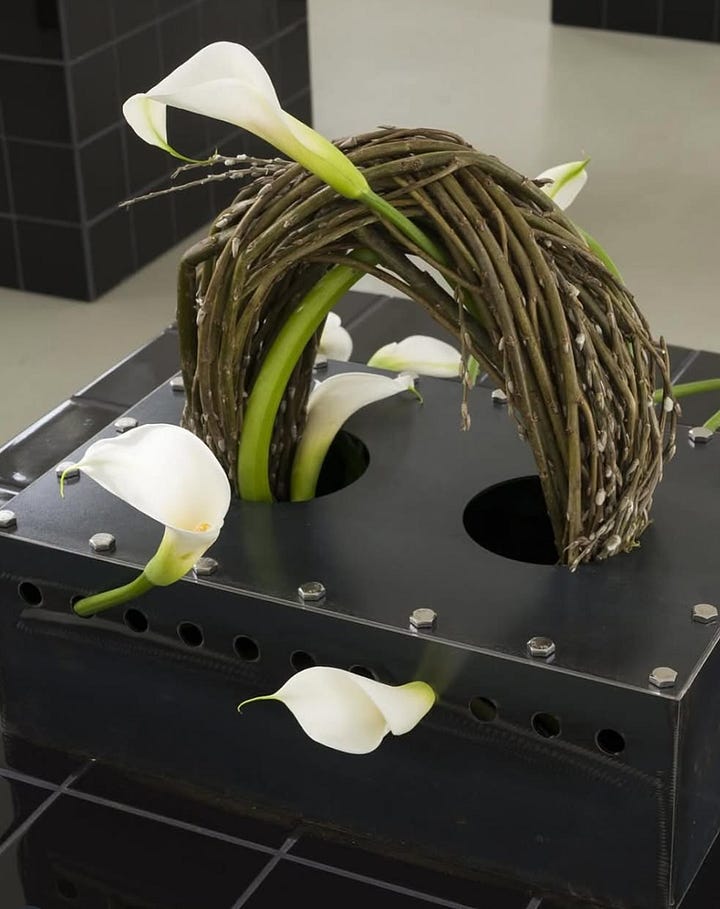

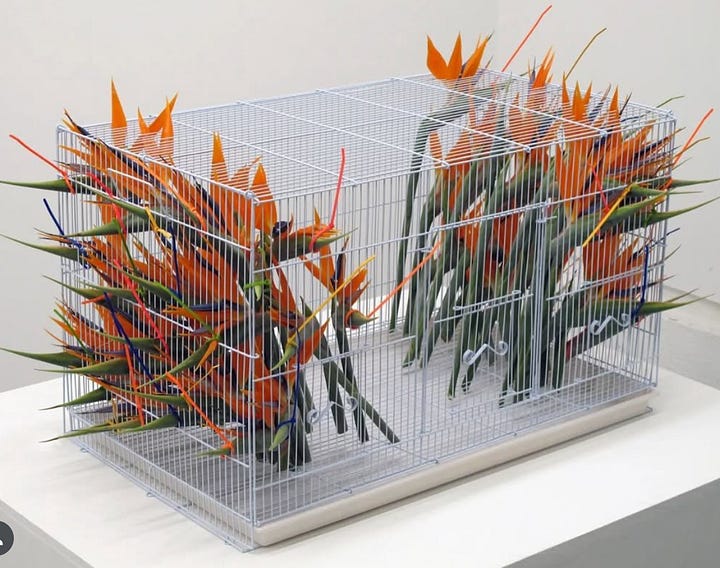
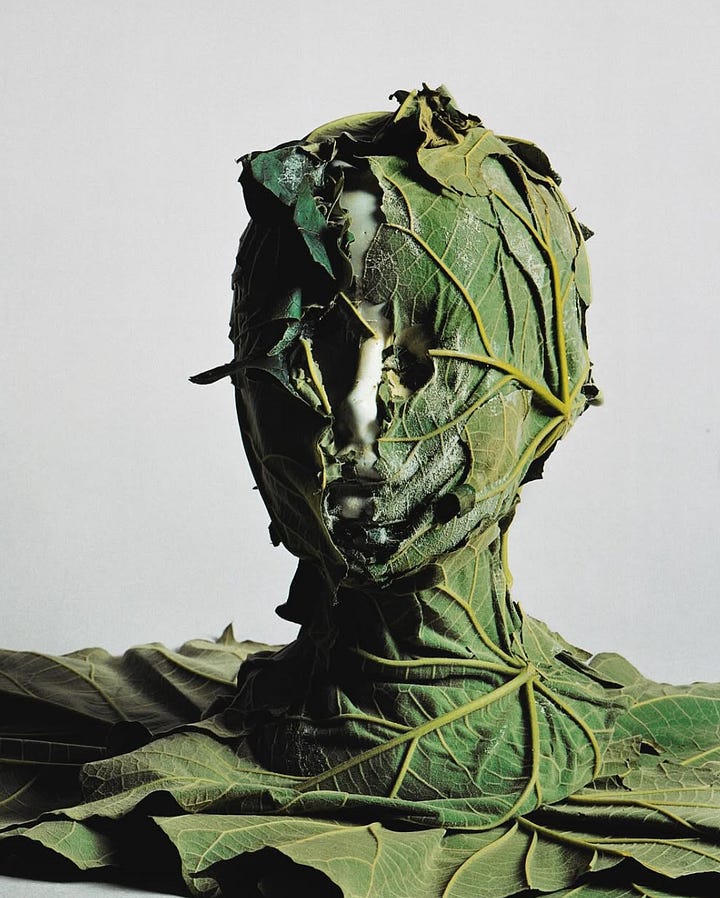
Founded by ikebana artist Kosen Ohtsubo and carried on by Berlin-based scholar Christian Kōun Alborz Oldham, Flower Planet is a studio known for their experimental botanical compositions that arrange twisting foliage and blooming flowers into surreal scenes of ecological beauty punctuated by more unusual materials like vegetables, bones, and manmade objects. Their freestyle approaches regularly defy the constrictions of typical vessels and the rigidities of the craft’s traditional aesthetic conventions. By turning to mundane things for sculptural inspiration, repurposing invasive species, and incorporating discarded plant clippings into their body of work, these artists unravel the pretentions of the practice, turning floral arrangements into moments that celebrate the beauty of everyday botany.
Battlefield is an ongoing multimedia, garden-based project by artist Gabriella Hirst that traces the official naming of plant cultivar names that make reference to armed conflict, war zones, and the military industrial complex. These varieties span 500 years of breeding in Western gardening, sourced primarily from across Europe. As Hirst writes, “With each plant carrying the language of violence and conflict, the garden asks us to consider how we may tend to difficult histories over time.” In addition to an online index, the physical Battlefield garden continues to crop up at new sites. These naming conventions, a planting guide, and Hirst’s reflections and research documentation are also archived in a gorgeous risograph publication.
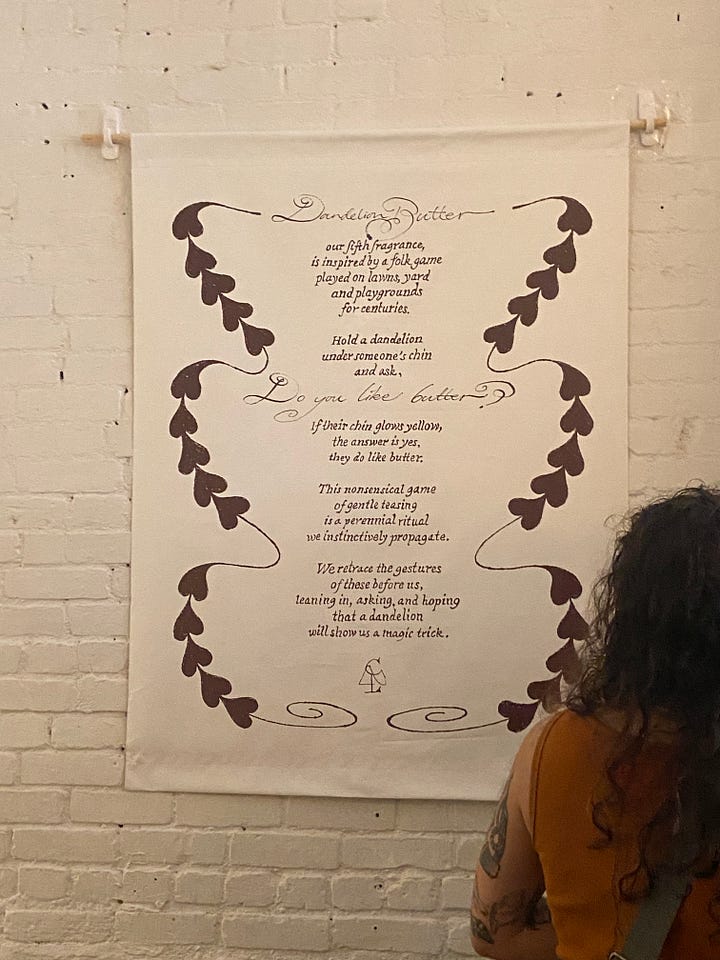
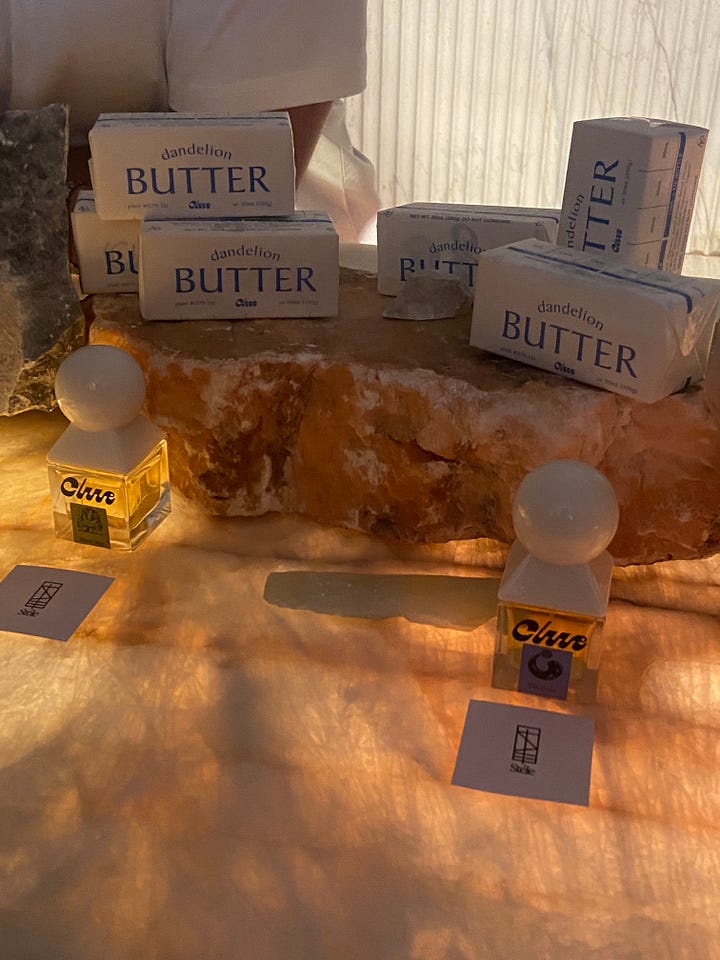
One of my highlights of this summer was definitely going to the launch of Clue Perfumery’s newest scent, Dandelion Butter, at Stele. Inspired by Midwestern memories of the childhood game “Do you like butter?,” the fragrance itself is a treat of stemmy, sappy golden deliciousness. I loved how this event and perfume buttered up the lowly dandelion weed into a symbol of joyful, nostalgic whimsy.
CLICK
Flowers are not just frivolous symbols of aesthetic beauty. Oftentimes, they are embodiments of political struggle, representing cultural histories of violence and resistance. Journalist Marta Vidal shares the story of one particular flower, the Faqqu’a Iris, and how it’s caught up in the brutal colonization and military occupation of Palestine. A rare and historic plant, Vidal reports on how the Israeli construction of separation walls and settler attacks have decimated the fields of blooms and threaten the region’s native biodiversity. While the physical and cultural genocide of Palestinians continues to be documented, Vidal invites us to extend that same awareness to the destruction of Palestine’s natural heritage. Even in the face of dispossession and displacement, human and flower alike remain resilient and refuse their oppression, growing together in hopeful defiance of extermination.
Displaying thriving plants in your home has long been an expression of social status, dating back centuries. Better Homes & Gardens looked at a century’s worth of houseplant interior design trends from the magazine’s own archives. This piece was such a delight to read, seeing how our taste in plants evolved with our changing society. Some examples: trailing plants were big in the 1970s, Depression-era decor scarcity led to more botanical furnishings, and the rise of terrariums in the early 2000s.
Ralph Waldo Emerson once wrote that the “earth laughs in flowers.” I was thinking about those words when I read Heather Swan’s piece about the Forest of Orchids, a cultivation project in the mountains of Colombia that heals environmental destruction through the planting of native orchids. I didn’t realize this, but Colombia is the world’s second largest exporter of flowers. This has resulted in industrial farming practices that pollute landscapes and harms to local soils and wildlife. The Hincapié family’s initiative doesn’t just bring beauty to what was once a barren landscape; their work represents an important revival of multispecies interconnection and cross-pollination that can resist ecological exploitation through beloved blooms.
I end, as always, with a poem. This time by Nate Klug, “Jasmine” blurs the boundaries between inside and outside through the drift of the flower’s fragrance. Reading this, I’m reminded of the jasmine bush that sprouted up under my window of my childhood home in Florida. Its interwoven encounters with the artificiality of our built world are reflected in Klug’s observations about the plant’s strange entanglements with plastic, wires, and wildlife. Klug muses: “While nothing changes; while the scent of jasmine / flutters and drifts, like sympathy, living for itself.”




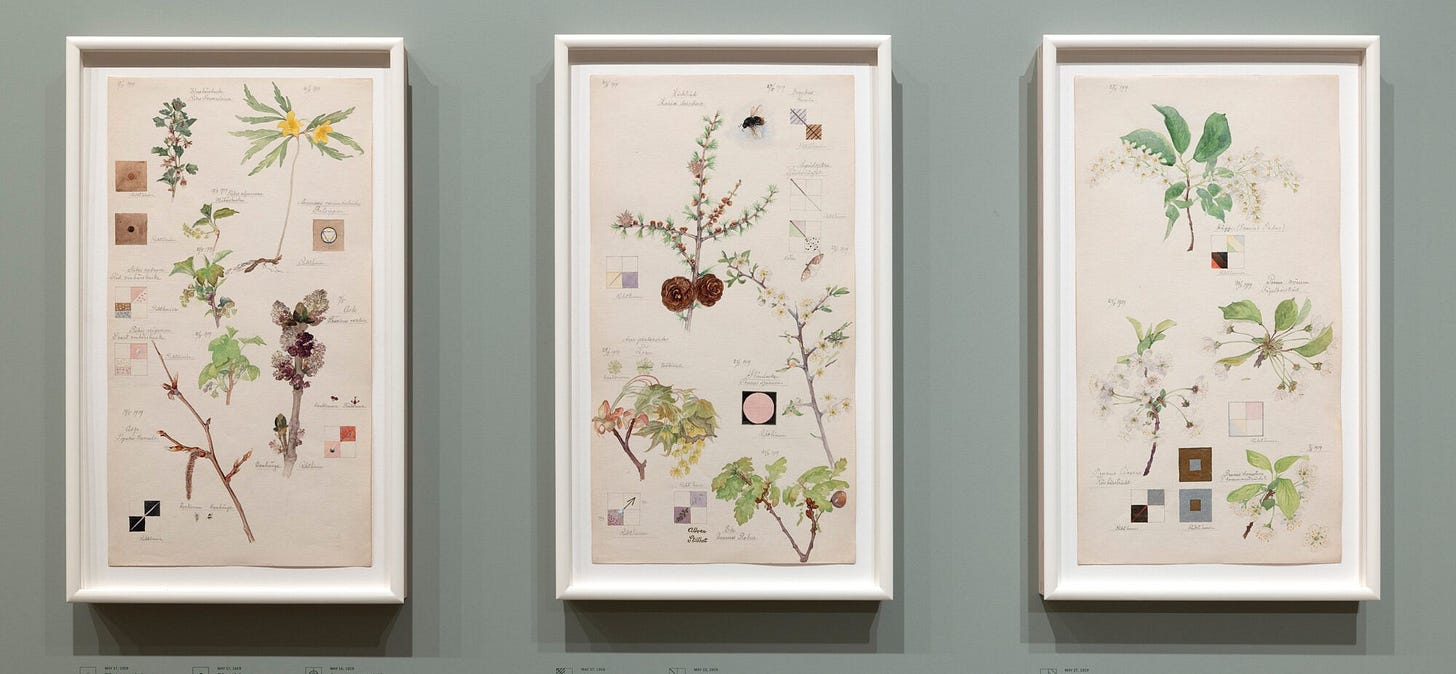

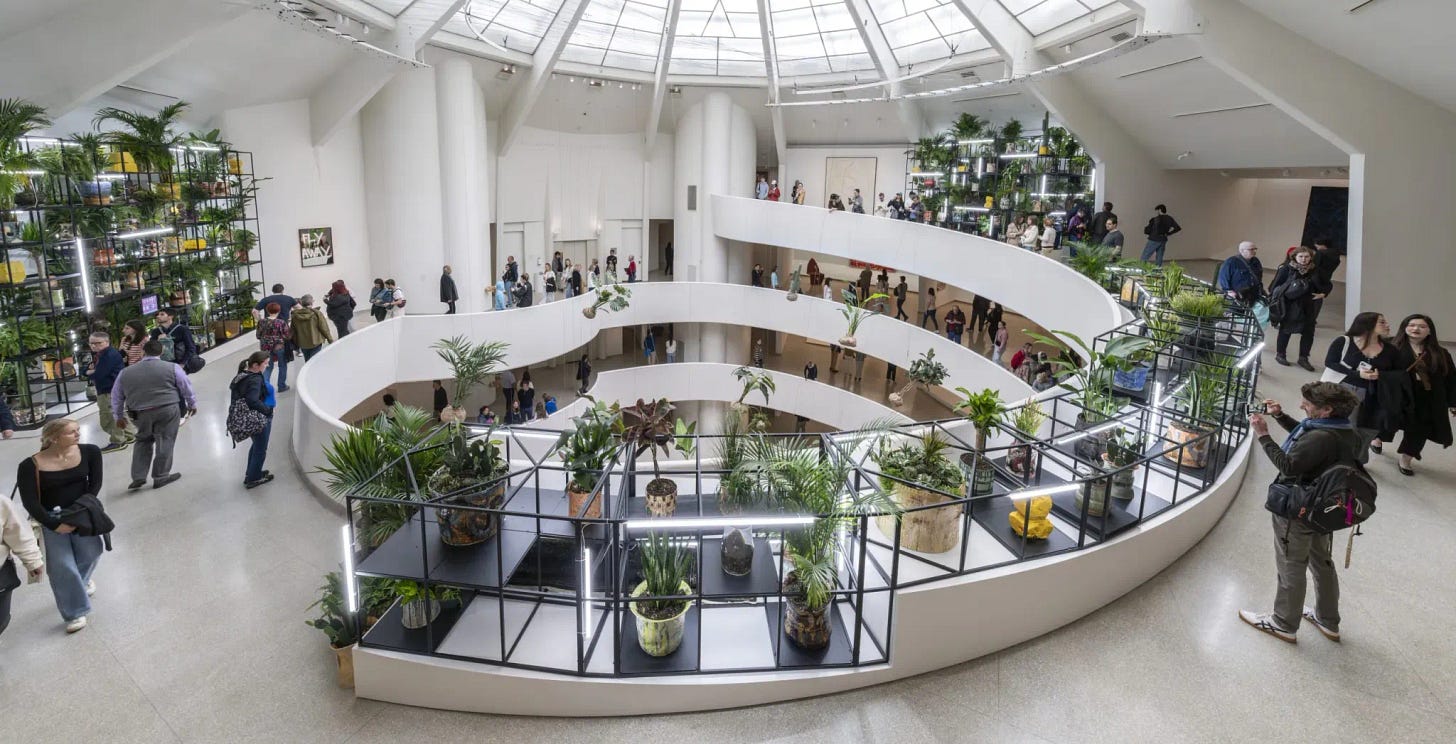
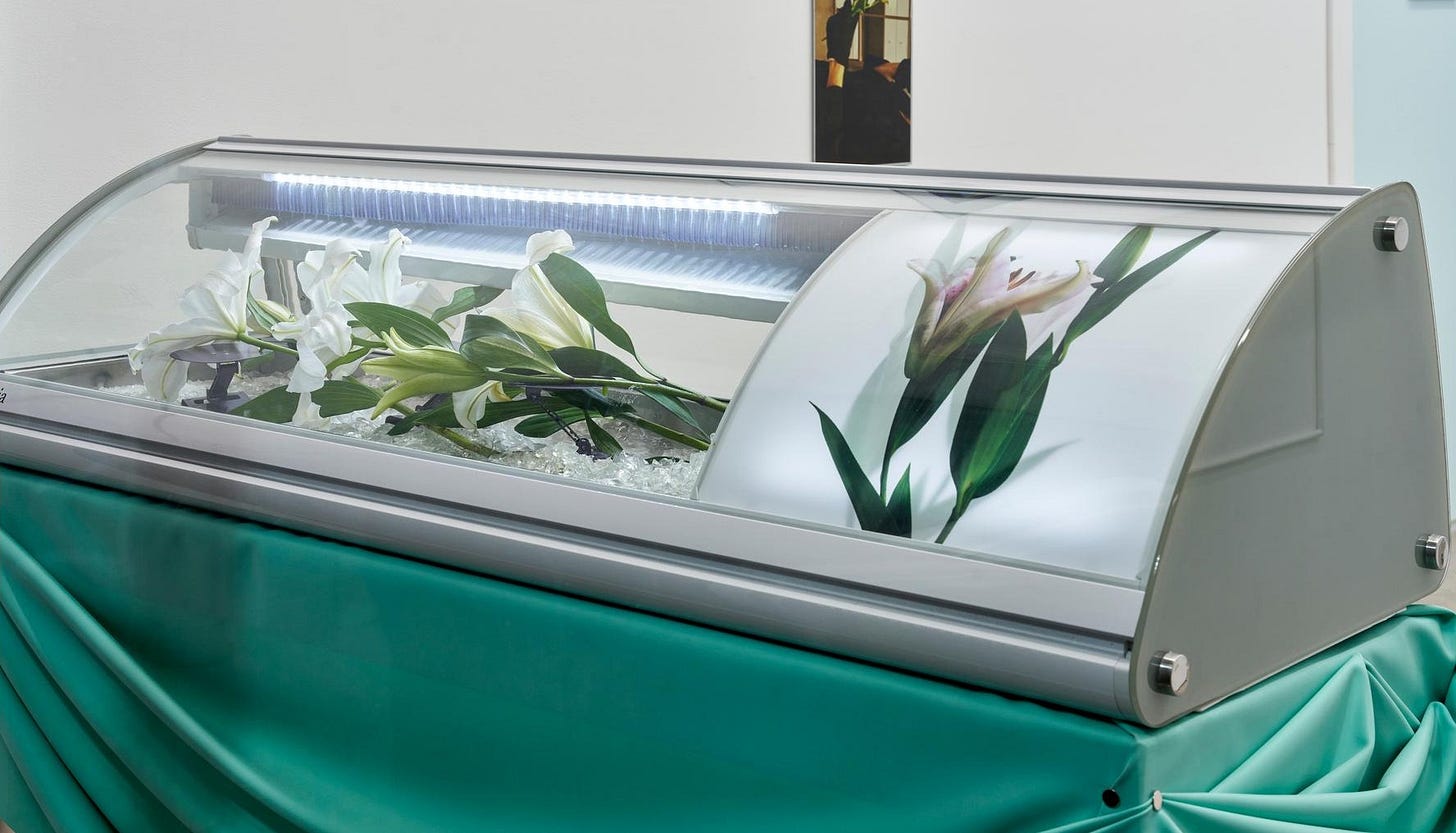

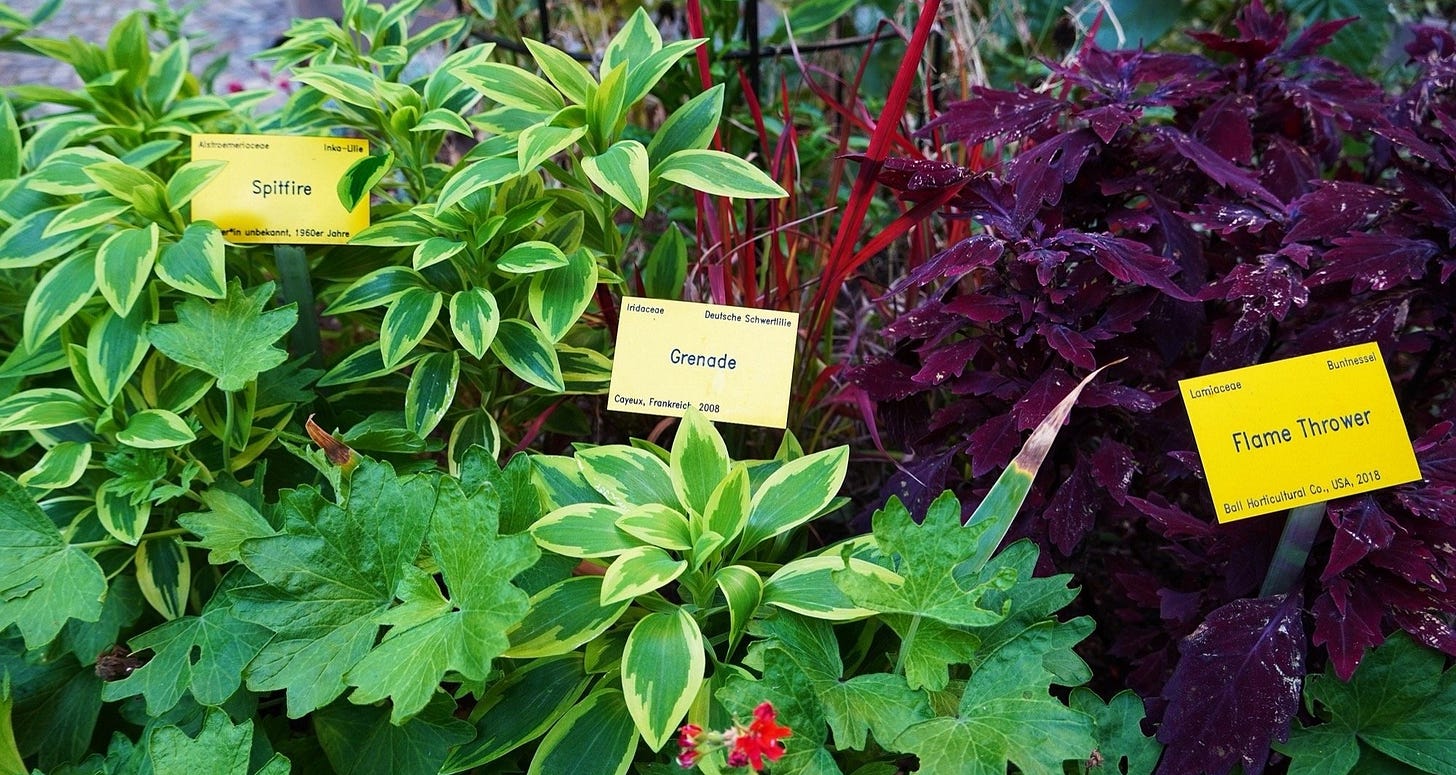
This is a lovely piece - your writings always makes me feel like I am on a trip visiting places and having new experiences. This was an especially fun breakfast vacation. Judy (friend of your grandmother)
Adore this piece 🌸